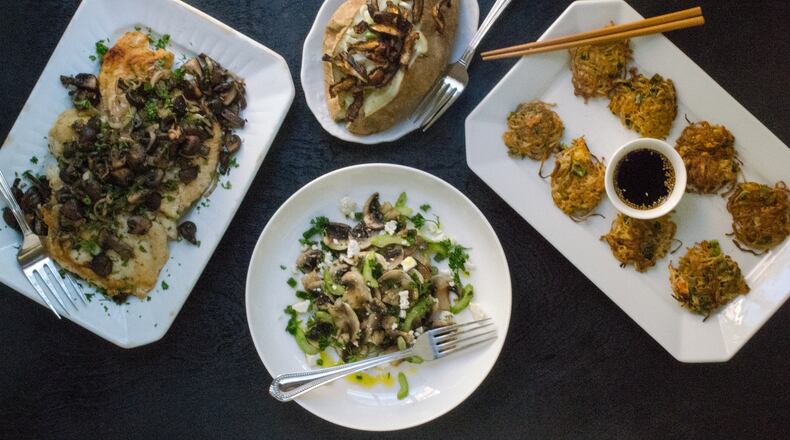Mushrooms are popping up at grocery stores, farmers markets, the pharmacy, and even on the streaming service Netflix with its hit film, “Fantastic Fungi.” They are being touted as mood enhancers, plant-forward meat replacements, and as functional foods that benefit the brain and nervous system. Mushroom advocates report tremendous health benefits from everything from lowering high blood pressure to reducing body mass index and even the size of cancerous tumors.
Multiple companies around the world are developing innovative fungal solutions to combat toxic waste spills, pests and disease. The Smithsonian Magazine recently reported that mushrooms may communicate with one another using electrical impulses. The WebMD website references that “some mushrooms can potentially prevent age-related dementia.” It seems there is nothing that mushrooms cannot do and gives a whole new meaning to the term “magic mushrooms.”
Mushrooms have been used by humans for thousands of years as food and medicine. More than 14,000 species of mushrooms are recognized, and among them, approximately 2,000 are edible. Mushrooms can be excellent additions to our daily diet. They are high in protein, fiber, carbohydrates, vitamins and minerals, and low in fat, calories and cholesterol. The meatiness of mushrooms is a result of both their toothsome texture and high umami content.
If mushrooms have been recognized for thousands of years, why the recent groundswell of support? Only recently have scientists had the technology to study fungi more fully and to explore the hidden, mysterious realms of mycelium that lie beneath us in the earth, mostly invisible to the naked eye. In the kitchen, mushrooms have benefited from increased consumer demand for functional foods, foods that have a potentially beneficial effect on health beyond basic nutrition, promoting optimal health and aiding in reducing the risk of disease.
For many years, the only mushroom variety found in the grocery store were white buttons. Then, portobello popped onto the scene, along with its diminutive version, cremini (aka baby bella). Shiitake found a foothold, and now, many traditional grocery stores offer these three of four more common mushrooms. (Interestingly, these more common mushrooms can be eaten raw. Not all mushrooms can be eaten raw as they can cause gastrointestinal distress and all benefit nutritionally from being cooked.)
As a result of recent science and changing demographic patterns, it’s increasingly common to see more exotic varieties at gourmet and farmers markets, as well as kits for growing your own. Mushroom cultivation has exploded in the past few years. There are multiple farms in Georgia that grow shiitake, oyster, lion’s mane, and reishi. Various logs and spawn inoculated with mushroom spores are available at local farmers markets as well as online.
My local Whole Foods regularly has a selection of maitake, enoki and trumpet, in addition to the more common varieties. Also, many local Asian markets offer a wide and exciting variety of mushrooms.
This collection of recipes uses the more commonly available mushroom varieties. I also encourage you to mix and match to see what kind of mushroom magic pops up in your kitchen.
Credit: Virginia Willis
Credit: Virginia Willis
Common mushrooms and their culinary uses
White button: White button mushrooms are mild in flavor, blend well with most ingredients, and have a flavor that intensifies when cooked.
Portobello and cremini: A lovely brown mushroom with a slightly earthy flavor that mixes well with other mushrooms. Firm flesh stands up to long cooking times. When cooked, portobello mushrooms have a chewy, meaty texture and a smoky, earthy flavor.
Shiitake: Shiitake mushrooms have a dense, chewy texture. They are intensely flavored and can be somewhat tough. The stems are so tough that they must be removed before cooking. Add the stems to stocks and broth.
Enoki: Enoki mushrooms are long and slender. Most often white, they grow in bouquets of tightly packed stems topped with tiny caps. Enoki have an earthy flavor and can be somewhat stringy due to their long fibers.
Oyster: Delicate, with petal-like caps growing out of a central group, oyster mushrooms are slightly chewy with a mild flavor. It’s not as common to see these in a supermarket, but you might find them in a packet of “gourmet mixed” mushrooms.
King trumpet: Also known as French horn mushrooms, these meaty shafts are the largest in the oyster mushroom family. With thick white stems and small brown caps, they are great for slicing lengthwise into plants or into medallions for cooking.
Beech: Beech mushrooms, also known as shimeji, are a variety of Asian mushrooms with a crunchy texture and nutty, savory flavor.
Maitake: Maitake mushrooms are a lacy bouquet also known as hen-of-the-woods. They have a delicate yet earthy flavor.
RECIPES
Add magic to mealtime with these fungi recipes. Meaty mushrooms are the star of the plate with fun fritters; a zesty salad; a crispy plant-based “bacon”; and a hearty, healthy main.
Credit: Virginia Willis
Credit: Virginia Willis
Enoki Mushroom Fritters
These Korean-inspired fritters or pancakes are quick and simple to prepare. There’s no need to deep-fry them as they will cook in a thin coating of oil in the skillet.
Credit: Virginia Willis
Credit: Virginia Willis
Mushroom and Celery Salad
The celery ceviche on the menu at the Betty in Buckhead features bright lemon, herbs and mushrooms. Inspired by this delicious salad, this recipe highlights the mushrooms and moves the celery to the supporting role. Serve this zesty, vibrant salad with lean grilled, baked or roasted meats such as chicken, fish or seafood.
Credit: Virginia Willis
Credit: Virginia Willis
Credit: Virginia Willis
Credit: Virginia Willis
Chicken Paillard with Sauteed Mushrooms
It’s certainly easy to purchase pre-sliced mushrooms, but try quartering mushrooms for a completely different mouthfeel. This recipe scales up easily, simply cook the chicken in batches.
Sign up for the AJC Food and Dining Newsletter
Read more stories like this by liking Atlanta Restaurant Scene on Facebook, following @ATLDiningNews on Twitter and @ajcdining on Instagram.
About the Author
The Latest
Featured






